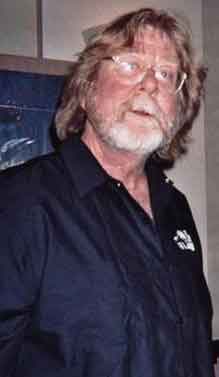 Quite simply, there was no one like the late Charlie Richard “Chas” Balun. An accomplished graphic artist, screenwriter (of the never-made Jim VanBebber feature CHUNKBLOWER), creature designer (for Fred Olen Ray’s 1992 EVIL TOONS) and pioneer in the field of genre self-publishing (with Chunkblow Press and Buckwheat Books), Chas is remembered primarily for his writing, which in addition to the books listed below turned up in periodic contributions to Fangoria and Gorezone (for which he wrote the “Piece O’ Mind” column from 1988 to 1991), and which from the start was notable for its caustic wit, intelligence and unbridled enthusiasm.
Quite simply, there was no one like the late Charlie Richard “Chas” Balun. An accomplished graphic artist, screenwriter (of the never-made Jim VanBebber feature CHUNKBLOWER), creature designer (for Fred Olen Ray’s 1992 EVIL TOONS) and pioneer in the field of genre self-publishing (with Chunkblow Press and Buckwheat Books), Chas is remembered primarily for his writing, which in addition to the books listed below turned up in periodic contributions to Fangoria and Gorezone (for which he wrote the “Piece O’ Mind” column from 1988 to 1991), and which from the start was notable for its caustic wit, intelligence and unbridled enthusiasm.
His favored subject? Cinematic gore, about which Chas Balun pontificated with the fervor of a preacher. In the process he popularized the term “chunkblower” and promoted obscure Italian and Asian gore films that were largely unknown to most of the rest of us.
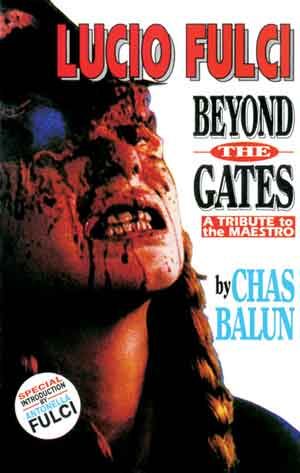 No less an authority than filmmaker Lucio Fulci proclaimed Balun “the king of splatter films.” That’s appropriate, as Balun’s early and tireless championing of Fulci’s films, I’d argue, is primarily responsible for the prestige they now enjoy; it’s a fact that Fulci was largely dismissed as a two-bit hack before Chas began his mid-eighties stumping. Balun even published LUCIO FULCI: BEYOND THE GATES (Blackest Heart Books; 1996), a fun 76-page book in which Chas airs his heartfelt and oft-hilarious views on Fulci’s films (on THE NEW YORK RIPPER, with its quacking psycho killer: “Why a fuckin’ duck?”). It’s hardly the definitive book on Fulci, but it is quite enjoyable, and imbued with a real affection for its subject.
No less an authority than filmmaker Lucio Fulci proclaimed Balun “the king of splatter films.” That’s appropriate, as Balun’s early and tireless championing of Fulci’s films, I’d argue, is primarily responsible for the prestige they now enjoy; it’s a fact that Fulci was largely dismissed as a two-bit hack before Chas began his mid-eighties stumping. Balun even published LUCIO FULCI: BEYOND THE GATES (Blackest Heart Books; 1996), a fun 76-page book in which Chas airs his heartfelt and oft-hilarious views on Fulci’s films (on THE NEW YORK RIPPER, with its quacking psycho killer: “Why a fuckin’ duck?”). It’s hardly the definitive book on Fulci, but it is quite enjoyable, and imbued with a real affection for its subject.
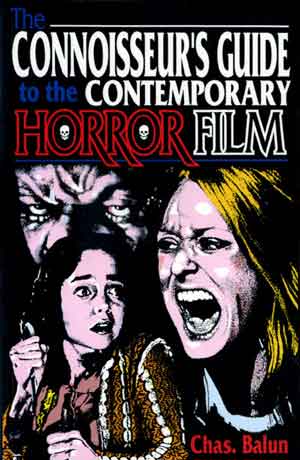 Chas, of course, published many other books and periodicals prior to the Fulci book. The first was THE CONNOISSEUR’S GUIDE TO THE CONTEMPORARY HORROR FILM (FantaCo Books; 1983/92), a 64-page horror movie review compilation that despite a preponderance of typos and oft-sloppy prose amply showcases the boundless enthusiasm that would come to characterize Balun’s writing. That Chas Balun was also an astute critic is proven repeatedly in this book, which provides intelligent critiques of genre stalwarts like ALIEN (in which “The spacecrafts, suits, planets and rampaging monster are all marvelously conceived originals while the plot is a simplistic re-hash of countless hack sci fi movies”) and HELLRAISER (“Barker can’t sustain his illusions without resorting to a convenient and familiar body-count formula”).
Chas, of course, published many other books and periodicals prior to the Fulci book. The first was THE CONNOISSEUR’S GUIDE TO THE CONTEMPORARY HORROR FILM (FantaCo Books; 1983/92), a 64-page horror movie review compilation that despite a preponderance of typos and oft-sloppy prose amply showcases the boundless enthusiasm that would come to characterize Balun’s writing. That Chas Balun was also an astute critic is proven repeatedly in this book, which provides intelligent critiques of genre stalwarts like ALIEN (in which “The spacecrafts, suits, planets and rampaging monster are all marvelously conceived originals while the plot is a simplistic re-hash of countless hack sci fi movies”) and HELLRAISER (“Barker can’t sustain his illusions without resorting to a convenient and familiar body-count formula”).
Another early publication was 1986’s HORROR HOLOCAUST (FantaCo), which is notable for its copious black-and-white stills and ad slicks, and also one of the greatest-ever cover illustrations. The text isn’t too shabby either, providing an in-depth take on splatter cinema that commences with an enthusiastic dissertation on THE TEXAS CHAINSAW MASSACRE and concludes with an extended rave about RE-ANIMATOR. In between are quick takes on everything from DAWN OF THE DEAD, CANNIBAL APOCALYPSE, THE DEADLY SPAWN, MARK OF THE DEVIL, RAW MEAT and (of course) the films of Lucio Fulci, all done in Chas’ spirited manner.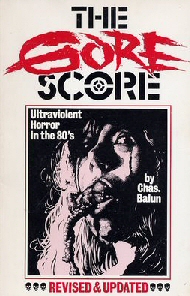
THE GORE SCORE, self-published in 1985 (though better known in the 1987 FantaCo edition), seems destined to be Balun’s most famous work. As the title indicates, the book is all about gore, with over 300 capsule reviews drafted in Chas’ inimitable style (on EVIL DEAD 2: “Idiot plot, disposable victims, but jeez, what a good time!”). Each entry is given two ratings, one for overall quality and another for the amount of bodily fluid shed onscreen. I don’t think I need to tell you which of the two ratings Chas’ readers prized more; just check out the introduction, in which Balun chides eighties-era filmmakers who “operated on the principal that a horror audience would sit through just about anything to see a graphic knife wound or a splashy decapitation,” only to grudgingly acknowledge that “For the most part, unfortunately, they were right.”
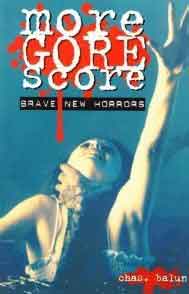 The book was popular enough that a MORE GORE SCORE (Fantasma Books) appeared in 1992 to cover horror films made after 1987 (including FRIDAY THE THIRTEENTH VIII, which “Sucks major league dick…and swallows”), followed nine years later by GORE SCORE 2001: THE SPLATTER YEARS (Obsidian Books). This volume runs a whopping 303 pages and features an admiring introduction by Jack Ketchum and a lengthy afterward by Stephen R. Bissette, along with reviews of the likes of THE BLAIR WITCH PROJECT (“an incompetent, scare-free, amateur home video”) and 1989’s NIGHT VISITOR (“goat shit served hot and runny on stale toast”).
The book was popular enough that a MORE GORE SCORE (Fantasma Books) appeared in 1992 to cover horror films made after 1987 (including FRIDAY THE THIRTEENTH VIII, which “Sucks major league dick…and swallows”), followed nine years later by GORE SCORE 2001: THE SPLATTER YEARS (Obsidian Books). This volume runs a whopping 303 pages and features an admiring introduction by Jack Ketchum and a lengthy afterward by Stephen R. Bissette, along with reviews of the likes of THE BLAIR WITCH PROJECT (“an incompetent, scare-free, amateur home video”) and 1989’s NIGHT VISITOR (“goat shit served hot and runny on stale toast”).
It may be too early to name the work that constitutes Chas Balun’s legacy, but I believe the iconic Deep Red magazine is a strong contender. It beg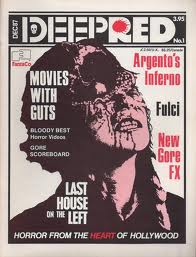 an as a 20-page fanzine self-published by Chas and Chris Amouroux in July 1986, which was notable primarily for a farcical interview with Godzilla conducted by Joe Dante. From there FantaCo published six more Balun-edited issues of Deep Red spanning December 1987 to March 1989.
an as a 20-page fanzine self-published by Chas and Chris Amouroux in July 1986, which was notable primarily for a farcical interview with Godzilla conducted by Joe Dante. From there FantaCo published six more Balun-edited issues of Deep Red spanning December 1987 to March 1989.
While other genre rags were covering NIGHTMARE ON ELM STREET and FRIDAY THE THIRTEENTH sequels, Deep Red lavished its attention on the likes of COMBAT SHOCK, STREET TRASH and DR. BUTCHER M.D. (a film whose appeal I’ll never understand but Chas loved dearly, claiming “It’s actually refreshing to see a film that knows its shit still stinks”). The mag was also a vocal supporter of the fiction of the great Jack Ketchum. Such staunch nonconformity is rare and salutary, as was the writing by Chas and contributors like Stephen Bissette, Dennis Daniel, Greg Goodsell and John Martin.
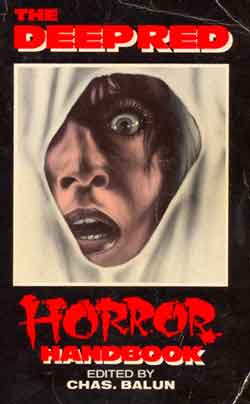 Following issue #6 was the 319-page FantaCo published DEEP RED HORROR HANDBOOK, which appeared in August of 1989. It included a lengthy Stephen Bissette authored overview of third world cannibal movies, an expanded reprint of THE GORE SCORE and Balun’s seminal essay “I Spit in Your Face: Films That Bite” (reprinted in the 1990 anthology SPLATTERPUNKS), which provided myself and many others with an introduction to essential chunkblowers like LAST HOUSE ON DEAD END STREET and NEKROMANTIK.
Following issue #6 was the 319-page FantaCo published DEEP RED HORROR HANDBOOK, which appeared in August of 1989. It included a lengthy Stephen Bissette authored overview of third world cannibal movies, an expanded reprint of THE GORE SCORE and Balun’s seminal essay “I Spit in Your Face: Films That Bite” (reprinted in the 1990 anthology SPLATTERPUNKS), which provided myself and many others with an introduction to essential chunkblowers like LAST HOUSE ON DEAD END STREET and NEKROMANTIK.
Following a two year hiatus Deep Red returned in the Winter of 1991, with a book-sized “Special Edition”–after which FantaCo, according to Balun, “dropped off the face of the Earth.” Yet Deep Red kept going in the form of two digest sized “Alerts” in fall 1991 and summer 1992, a Blackest Heart Media published 1997 issue, and in 2002 a “15th Anniversary Special” from Rotten Cotton Graphics. That issue, which turned out to be Deep Red‘s last, featured Balun’s essential “50 Red Letter Moments in Splatter History” and also the true, none-too-exciting account of the notorious early-nineties flap involving Balun, Charlie Sheen and the “Flower of Flesh and Blood” episode of the Japanese GUINEA PIG series.
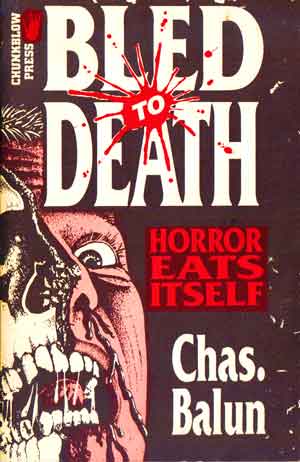 A frequent lament expressed in DEEP RED was Balun’s dissatisfaction with the horror movie scene of the eighties and nineties. His thoughts were further elucidated in two heavily illustrated 30-page booklets, one written near the beginning of the nineties and the other toward the end. Both are pretty grim and, sadly, spot-on in their observations.
A frequent lament expressed in DEEP RED was Balun’s dissatisfaction with the horror movie scene of the eighties and nineties. His thoughts were further elucidated in two heavily illustrated 30-page booklets, one written near the beginning of the nineties and the other toward the end. Both are pretty grim and, sadly, spot-on in their observations.
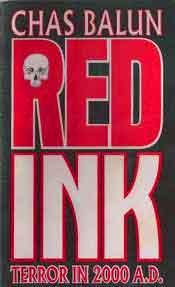 Starting with the words “The horror film is dead,” 1993’s BLED TO DEATH: HORROR EATS ITSELF (Chunkblow Press) focuses primarily on the obnoxious sequels and so-called “erotic thrillers” that characterized horror cinema back then, and also takes shots at directors abandoning the genre and the failure of the NC-17 rating. 1999’s RED INK: HORROR IN 2000 A.D. (Blackest Heart Media), on the other hand, takes on the SCREAM flicks and their countless wannabes, as well as the annoying remake trend that was beginning to proliferate. Each book concludes with a list of must-see gore movies, and BLED TO DEATH even has a recommended books section (in which Chas. calls Dean Koontz a “little dweeboid”).
Starting with the words “The horror film is dead,” 1993’s BLED TO DEATH: HORROR EATS ITSELF (Chunkblow Press) focuses primarily on the obnoxious sequels and so-called “erotic thrillers” that characterized horror cinema back then, and also takes shots at directors abandoning the genre and the failure of the NC-17 rating. 1999’s RED INK: HORROR IN 2000 A.D. (Blackest Heart Media), on the other hand, takes on the SCREAM flicks and their countless wannabes, as well as the annoying remake trend that was beginning to proliferate. Each book concludes with a list of must-see gore movies, and BLED TO DEATH even has a recommended books section (in which Chas. calls Dean Koontz a “little dweeboid”).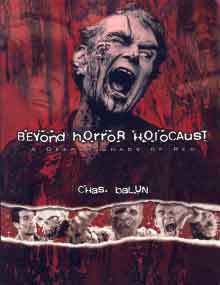
The 2000s saw Chas settling into his final decade, and falling uncharacteristically silent. Following GORE SCORE 2001 and the final issue of Deep Red he published BEYOND HORROR HOLOCAUST: A DEEPER SHADE OF RED (Fantasma Books) in 2003. A sequel to the above mentioned HORROR HOLOCAUST, BEYOND… shows that Balun remained every bit the profane, unapologetically splat-happy horror enthusiast he was back in 1986. There are knowledgeable entries on genre standbys like THE EVIL DEAD, CANNIBAL HOLOCAUST and RE-ANIMATOR, as well as more obscure titles like EVIL CLUTCH, THE 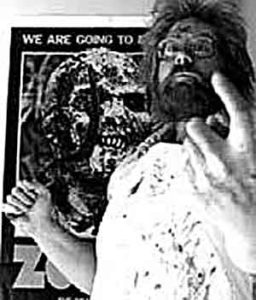 SUPERNATURALS and AFTER DEATH. The photographic illustrations are voluminous, often taking up entire pages, and include a set of stills from RE-ANIMATOR that concretely visualize the infamous “Giving Head” sequence.
SUPERNATURALS and AFTER DEATH. The photographic illustrations are voluminous, often taking up entire pages, and include a set of stills from RE-ANIMATOR that concretely visualize the infamous “Giving Head” sequence.
As it turned out, BEYOND HORROR HOLOCAUST was Balun’s final book. Following a lengthy battle with cancer Chas died on December 18, 2009, at the far-too-young age of 61.
R.I.P. Chas. Balun. Truly, there will never be another.
Fiction by Chas
Before we go, let’s take a quick look at the three fictional works published by Chas Balun. None of the three is a masterpiece, but all showed definite promise.
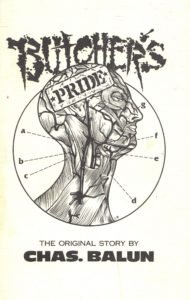 First up is the 20 page BUTCHER’S PRIDE (Buckwheat Books; 1989), an impressively concentrated exercise in splatterific excess. In a nonfiction forward Chas claims this tale was the basis of a 1988 movie to be headlined by THE TEXAS CHAINSAW MASSACRE’S Gunnar Hansen and directed by Balun himself, but wound up appearing in its present form after the production fell apart (an explanation for which is provided in Deep Red #6).
First up is the 20 page BUTCHER’S PRIDE (Buckwheat Books; 1989), an impressively concentrated exercise in splatterific excess. In a nonfiction forward Chas claims this tale was the basis of a 1988 movie to be headlined by THE TEXAS CHAINSAW MASSACRE’S Gunnar Hansen and directed by Balun himself, but wound up appearing in its present form after the production fell apart (an explanation for which is provided in Deep Red #6).
The narrative is simple enough, with a young street punk identified as Nicky the Nazi picked up by the psychotic surgeon George and his wife Martha. Over the course of untold months George and Martha subject Nicky the Nazi to unspeakable torture and even more unspeakable medical experimentation, the effects of which are described thusly: “Lesions, pits, sacs of slippery globule-like things hanging from his stomach; things which were shaped like a newly-designed prototype for future organs attached to him, inside him, hanging from his body…” Yes, Chas definitely had a flair for (to use one of his favored expressions) the splatter that matters, as he further demonstrates in the story’s conclusion, in which Nicky the Nazi gets his long-in-coming revenge on George and Martha, resulting in lines like “all she could do was look down, lip-less, tongue-less, dying in horror, as he pulled her beating heart out from her chest and into his famished mouth.”
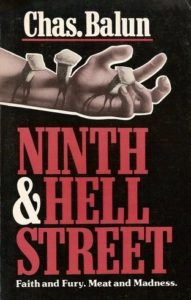 The more expansive NINTH & HELL STREET (Chunkblow Press; 1989) followed. It outdoes the previous entry, and most all splatterpunk fiction, in sheer nastiness, packing an amazing amount of bloodletting into its 157 pages. The subject is a band of Laguna Beach, CA based religiosos who take the torment and flagellation undergone by their lord and savior a bit too seriously. This results in a wave of outrageously bloody sacrifices that commence, appropriately enough, on Easter Sunday.
The more expansive NINTH & HELL STREET (Chunkblow Press; 1989) followed. It outdoes the previous entry, and most all splatterpunk fiction, in sheer nastiness, packing an amazing amount of bloodletting into its 157 pages. The subject is a band of Laguna Beach, CA based religiosos who take the torment and flagellation undergone by their lord and savior a bit too seriously. This results in a wave of outrageously bloody sacrifices that commence, appropriately enough, on Easter Sunday.
That’s a pretty thin premise, but plotting clearly wasn’t Balun’s primary interest. It’s the red stuff that really matters here, lovingly enumerated in prose that’s downright pornographic in its fetishistic detail. Balun also finds some time for characterization, with the protagonist, a 40ish ex-hippie crime enthusiast (clearly patterned after the author himself), being a surprisingly well-rounded individual. So too is his love interest, a devastated young woman whose sister is a victim of the insanity, and whose grief over the loss is well described and convincing. Their romance is nicely detailed, so much so that the ultra-nihilistic conclusion actually carries some genuine emotional impact.
Sadly, the novella DIRECTOR’S CUT (Blackest Heart Boo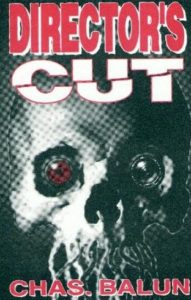 ks; 1995) was the final work of fiction by Mr. Balun. It’s a slight but robust 82 page work notable, once again, for its lovingly described bloodletting. There is, however, an extra dimension to DIRECTOR’S CUT that places it on a slightly elevated level, demonstrating Balun’s maturation as a storyteller.
ks; 1995) was the final work of fiction by Mr. Balun. It’s a slight but robust 82 page work notable, once again, for its lovingly described bloodletting. There is, however, an extra dimension to DIRECTOR’S CUT that places it on a slightly elevated level, demonstrating Balun’s maturation as a storyteller.
The setting is a reality based horror nerd milieu Balun knew extremely well, with filmmaker Jeff Rollins screening a heretofore unseen director’s cut of his horror opus ZOMBIE BLOODBATH at the Director’s Guild Theater in Hollywood, with a bevy of journalists, businessmen and slavering fanboys in attendance. Also afoot is a psychopath privy to the sordid secrets of Rollins’ past, which include a dead spouse and mass murder on a film set. The psycho has been creating his own horror opus, one that involves real-life bloodletting, and now all he needs is a grand finale—which he’s planning on creating at the ZOMBIE BLOODBATH screening. The tale is a strong one: tightly wound, suspenseful and lethally accurate in its none-too-affectionate depiction of the gorehound community. DIRECTOR’S CUT can actually be viewed as Balun’s own STARDUST MEMORIES or MISERY, i.e. a sharply critical rejoinder to his longtime fans and the subculture they inhabit, which is revealed here as a grimy gathering of socially deficient dimwits not entirely undeserving of the gruesome fates many of them meet in the remorseless climax. I wish I could say I disagree with that assessment, but…
